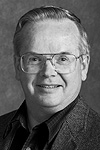 large team led
by materials scientist Ron Scanlan designed, built and tested the new
magnet, which is one meter in length and diameter, weighs about seven
tons, and features coils wound out of 14 miles of niobium-tin wire. After
being "trained," the magnet reached a peak field strength of 13.5 Tesla,
which is about a quarter of a million times stronger than the magnetic
field of Earth. This far-surpasses the previous high of 11.03 Tesla, and
is about triple the strength of the superconducting dipole magnets at
the Tevatron, the highest energy particle accelerator in the world.
large team led
by materials scientist Ron Scanlan designed, built and tested the new
magnet, which is one meter in length and diameter, weighs about seven
tons, and features coils wound out of 14 miles of niobium-tin wire. After
being "trained," the magnet reached a peak field strength of 13.5 Tesla,
which is about a quarter of a million times stronger than the magnetic
field of Earth. This far-surpasses the previous high of 11.03 Tesla, and
is about triple the strength of the superconducting dipole magnets at
the Tevatron, the highest energy particle accelerator in the world.
"We were in unknown territory, and even though we carefully tested
all of the components during construction, we could not know for certain
what we had until we tested the completed magnet," Scanlan said of the
new magnet, which is the first to use niobium-tin for its superconducting
coils.
The inherent limitations of conventional electromagnets which cannot
attain a dipole field strength much above 2 Tesla has necessitated the
continuing development of new and better superconducting alloys. However,
the use of high-field strength superconducting electromagnets has always
been a considerable technical challenge, because superconductivity tends
to weaken and disappear in the presence of a strong magnetic field.
In recent years, the alloy of choice for accelerator magnets has been
niobium-titanium. Superconducting magnets made from this alloy operate
in all of today's most powerful machines and will be used in the Large
Hadron Collider (LHC) now being built at CERN. The LHC magnets are expected
to operate at field strengths approaching the 10 Tesla mark that is
considered to be the upper limit of niobium-titanium accelerator magnets.
In the search for superconductors capable of reaching even higher field
strengths, it was determined that niobium-tin could, in principle, fit
the bill. However, unlike niobium-titanium, niobium-tin is a non-ductile
material, thought to be too fragile and brittle to withstand the stress
of fabrication.
| Lead scientist on this project
|
|
|
|
|
|
Scanlan and his team overcame the brittleness obstacle by making their
cable from separate strands of niobium and tin in a copper composite
strand while the materials were still ductile. Only after they wound
their cable into four magnet coils did they meld the separate niobium
and tin strands into the compound that is so brittle. Once the four
coils were assembled into a dipole magnet they had to be cooled to a
temperature of about 4.3 Kelvin (-270 degrees Celsius) to make them
superconducting. To withstand this and other stresses, the wound coils
were impregnated with an epoxy filler.
After being filled with epoxy, each coil was encased in an iron yoke
that contributed to the strength and stability of the magnetic field.
The coils were then wrapped in 18 layers of sheet stainless steel, forming a collar that prevents the coils from separating under the force generated when their tremendous magnetic field is energized.
In addition to serving as the model for the dipole magnets that will
be used in the next generation of high-energy particle accelerators,
this new magnet will also be used at Berkeley Lab as a test facility
for evaluating superconductors that could yield even more powerful magnets in the future.
- Lynn Yarris



 large team led
by materials scientist Ron Scanlan designed, built and tested the new
magnet, which is one meter in length and diameter, weighs about seven
tons, and features coils wound out of 14 miles of niobium-tin wire. After
being "trained," the magnet reached a peak field strength of 13.5 Tesla,
which is about a quarter of a million times stronger than the magnetic
field of Earth. This far-surpasses the previous high of 11.03 Tesla, and
is about triple the strength of the superconducting dipole magnets at
the Tevatron, the highest energy particle accelerator in the world.
large team led
by materials scientist Ron Scanlan designed, built and tested the new
magnet, which is one meter in length and diameter, weighs about seven
tons, and features coils wound out of 14 miles of niobium-tin wire. After
being "trained," the magnet reached a peak field strength of 13.5 Tesla,
which is about a quarter of a million times stronger than the magnetic
field of Earth. This far-surpasses the previous high of 11.03 Tesla, and
is about triple the strength of the superconducting dipole magnets at
the Tevatron, the highest energy particle accelerator in the world.
